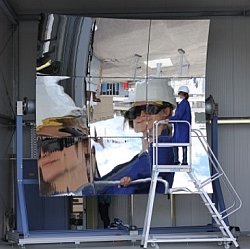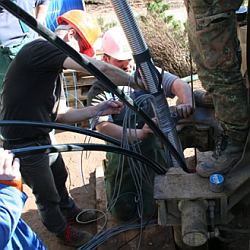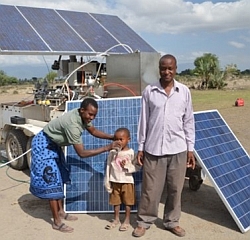Fossil fuels are of limited availability, produce CO2 emissions, and enhance the greenhouse effect. Consequently, the share of renewable energy sources will be increased in Germany and worldwide. To cover energy consumption of a modern industrial society with renewable energy sources, a number of technological approaches and smart networking are required. KIT research focuses on different facets of an energy system based on renewable sources. Topic 2 of the KIT Energy Center covers work relating to primary energy sources, such as solar power, wind power, biomass, and geothermal energy.
 |
Biomass During combustion, biomass effectively emits only as much CO2 as the plant took up from the atmosphere during its growth. Hence, the CO2 balance of biomass is much more favorable than that of fossil fuels. In large parts of the world, biomass still is used as a combustible for heating and cooking. Apart from this inefficient traditional use, modern technologies are being developed for biomass utilization. |
 |
Photovoltaics Solar cells are used to tap the sun as a nearly inexhaustible energy source. KIT works on improving the efficiency and service lives of solar modules. Novel photovoltaics concepts, such as organic solar cells, can be applied in urban areas covered by buildings. Architectonically attractive solar cells are developed for integration into facades. In addition, mobile energy supply concepts based on thin-layer solar cells are studied. |
 |
Concentrating Solar Thermal Power Plants Concentrating solar thermal power plants use mirrors to focus sunlight. Thanks to the high energy fluxes and temperatures achieved and the good storage properties of heat, efficient power plant processes based on solar energy and capable of producing both base and peak power can be implemented. High-temperature heat can also be used directly in industrial processes. Research of KIT covers liquid metals as heat transfer media for the use of solar thermal energy. For testing these liquid metals, the “SOMMER” pilot plant was built. |
 |
Geothermal Energy The earth holds unimaginable energy potentials. The heat stored in the top three kilometers of the earth’s crust alone theoretically is sufficient to cover the current worldwide energy demand for a period of 100,000 years. By human standards, geothermal energy, hence, is nearly unlimited. It can be used decentrally, only little space is required, and hardly any emissions are produced. |
 |
Integrated Water-energy Cycle Management Water supply and energy supply are closely linked. To cope with water scarcity, highly energy-intensive methods are frequently used, e.g. seawater desalination. Climate change, population growth, and environmental pollution increase the need for energy-intensive water treatments. However, areas suffering from water scarcity and the associated limitations of development and health are often lacking a reliable power grid. Integration of renewable energy sources into the water cycle will produce unprecedented synergies between the water and energy systems, which can be used efficiently. |